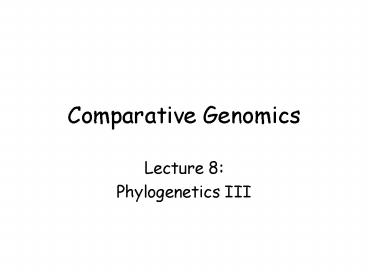Comparative Genomics - PowerPoint PPT Presentation
1 / 41
Title:
Comparative Genomics
Description:
Rate variation across sites in a protein-coding gene (first positions in ... Clock trees allow dating; non-clock trees do not. But clock trees poor fit to most data ... – PowerPoint PPT presentation
Number of Views:49
Avg rating:3.0/5.0
Title: Comparative Genomics
1
Comparative Genomics
- Lecture 8
- Phylogenetics III
2
Topics
- Stochastic models of protein evolution
- Rate variation
- Bayesian model selection
- Clock trees and non-clock trees
- Models of codon evolution and positive selection
- Mapping characters onto phylogenies
- Classification
3
Stochastic models of protein evolution
4
The 20 Amino Acids
- Four groups
- Hydrophobic neutral
- Hydrophilic neutral
- Acidic (- charge)
- Basic ( charge)
5
Protein models 1
The Poisson model Essentially a Jukes-Cantor model
6
Protein models 2
The Equalin model A generalized Felsenstein 1981
model
7
Protein models 3
The GTR model 208 free parameters (189 rates, 19
state freqs) Too many parameters for most datasets
8
Protein models 4
A fixed rate model (Jones, Dayhoff, ...)
9
Fixed rate models
- Jones General
- Dayhoff General
- Mtrev Mitochondrial proteins
- Mtmam Mammal mitochondrial proteins
- Wag General
- Rtrev Reverse transcriptase, retroviruses
- Cprev Chloroplast proteins
- Blosum General
- Vt Vertebrate proteins
(Do Citations in MrBayes to find out more)
10
Rate variation across sites
11
Rate Variation Across Sites
Gamma distribution The shape of the distribution
is determined by a single parameter, the shape
parameter a
12
Rate variation across sites in a protein-coding
gene (first positions in replicase based on nine
bacteriophages)
rate
site position
13
Spatial autocorrelation is effected by codon
position in protein-coding genes
autocorrelation
positions away
(from Yang 1995)
14
Bayesian model testing
15
Bayesian Model Testing
- The normalizing constant in Bayes theorem, the
marginal probability of the model or f(X), can be
used for model testing - f(x) can be estimated by taking the harmonic mean
of the likelihood values from the MCMC run
(MrBayes will do this automatically with sump) - Critical values in Kass and Raftery (1997)
- Any models can be compared nested, non-nested,
data-derived - With Bayes factor comparisons, you do not need to
decide first on the prior probability of the
models (implicitly equal probability)
16
Bayes theorem
Model likelihood
17
Bayesian Model Testing
Posterior model odds
Bayes Factor
18
Bayes Factor Comparisons
19
Standard models of branch lengths
Non-clock tree
Strict clock tree
- Clock trees allow dating non-clock trees do not
- But clock trees poor fit to most data
20
Codon models
21
Codon models
- If the change involves more than one nucleotide
substitution, the rate is 0 - If the change involves one nucleotide
substitution, the rate is equivalent to that
nucleotide substitution rate - If the change is non-synonymous, the rate is a
factor ? of the base rate - ? gt 1 -gt positive selection
- ? lt 1 -gt negative selection
- We can let ? vary over sites and infer the
evolutionary pressure at each site
22
The Universal Code
Second position
First position
23
Codon models
Goldman-Yang/Muse-Gaut model 601 parameters
24
Protein structure of the influenza hemagglutinin
protein, chains A and B. The seven positively
selected residues shown in red. They were
identified by simulation from the posterior
distribution of a Bayesian MCMC analysis.
Huelsenbeck et al. Science 2942310, 2001
25
Mapping characters onto phylogenies
26
Mapping Uncertainty
parsimony
ML
Bayesian
27
Phylogenetic and Mapping Uncertainty
28
Phylogenetic classification
29
Phylogenetic Classification
Only monophyletic groups (clades, natural groups)
should be recognized in a biological
classification
Monophyletic groups include AB, ABC, ABCD, GH,
FGH, and EFGH
Examples of non-monophyletic groups include AC,
EF, ECD, and AG. These should not be recognized
as groups in a biological classification.
30
Can we detect molecular adaptations in diving
mammals?
31
Can we find an appropriate model organism for
studying disease X?
32
Where and how did disease X originate?
33
How can we find suitable targets for design of
antiviral drugs?
34
How often does mutation X, which causes disease
Y, originate?
35
Why is species X similar to the unrelated species
Y?
36
Is the current classification of organism group X
correct?
37
Are there genes that evolve in a clock-like
fashion such that we can use a molecular clock to
date past events?
38
Which gene is best for identification of strains
of virus X?
39
Can we use phylogenies to identify a virulence
factor in a group of disease-causing bacteria?
40
Is there a correlation between the structure of
gene X, implied in aging processes, and longevity?
41
Can we use the comparative approach to find a
heat stable version of an enzyme involved in the
production of vitamin C?































